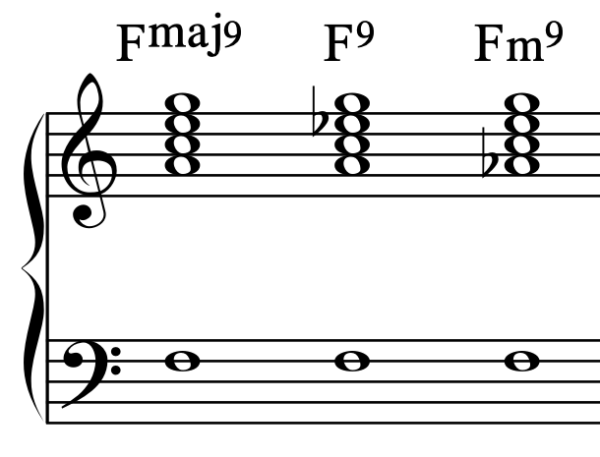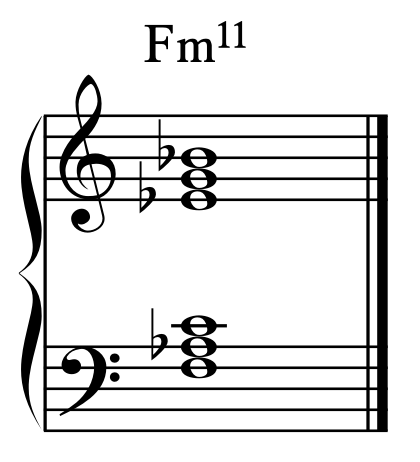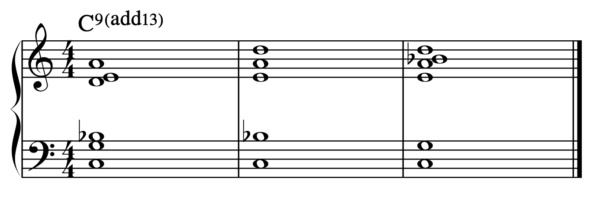Easy steps to learn jazz piano episode 6
The 3 extensions
In these easy steps to learn jazz piano we have reached the three extensions and ways to use them.
These three extensions are 9, 11 and 13. You can think of them as 2, 4 and 6 of the Mixolydian mode. You can get the same result by using the major scale, but I’m choosing the Mixolydian mode as this relates to the dominant 7 chord because it is in combination with this chord that the 4 alterations (otherwise known as altered notes) are mostly used.
The Mixolydian mode of F is F, G, A, Bb, C, D, Eb. Therefore the three extensions in this row are G (2 or 9), Bb (4 or 11) and D (6 or 13).

Before we go any further I need to make one thing clear. I recognise that the notes 13 and 6 and the notes 4 and 11 have different functions even though they are the same note. For example, the 6 usually sits inside the chord and the 13 sits above it. However, my aim is for you to recognise the sound of these notes. And so when I am referring to the note A combined with C7 it may sometimes be described as 6 and at other times as 13. But in both scenarios I’m wanting you to hear the sound it makes.
Although I have been emphasising that extensions and alterations add spice to the dominant 7 chord they can also be used as an addition to most other chords as well.
Let’s begin by taking a look at the first extension: the 9.
9: the first extension.
Here are three 7th (4-note chords) with the 9 added at the top.

Chord 1 is Fmaj9. Note that without the F as root in the bass clef the chord looks like Amin7.
Chord 2 is F9. This is the same as F7 + 9. Note that without the F as a root in the bass clef the chord looks like Amin7(b5)
Chord 3 is Fmin9. Note that without the F as a root in the bass clef the chord looks like Abmaj7.
Below is a simple phrase using just two chords: Fmaj7 and D7. On the strong beats I am playing the 9 of each chord, indicated in red.

My easy steps to learning jazz piano now lead us on to the next of the three extensions.
The second extension: 11
I first want you to see and hear this combination of chords that produce a unique voicing.

My left hand plays an F minor triad and my right hand plays an Eb major triad. The combination of these two chords produce Fmin11. Try playing any minor triad with you left hand and then, with your right hand play a major triad 2 steps down from the root of the first. This will produce the sound you hear above.
Songwriters using the sweet notes.
All the great songwriters make use of these ‘sweet notes’, often placing them on the strong beats of the bar. See and hear how Victor Young uses the 11 at the start of bars 1 and 3.


Notice that in the audio I have added the note F# to the first chord. This is a 9.
The third extension: 13
Here are three dominant 7 chords. All three are C7.

These three dominant 7 chords all contain 9 and 13 with different voicings.
As I have said above, 13 and 6 have different functions although they are the same note. The 6 usually sits inside the chord and the 13 sits above it. However, my aim is for you to recognise the sound of these notes. So here is another example of the songwriter choosing a ‘sweet note’ in this case it’s the first two bars of Moonlight in Vermont.

Yes, the first note of bar 1 is a 6 rather than a 13, but I’ll say again, listen and start to recognise the sound. The first note of bar 2, when sounded above Fmin7 is 9, but when carried through to combine with Bb7 it is now the 6.
And here’s a Youtube video of this article.
These easy steps to learn jazz piano have so far led us from V-I to II-VI and now some of the notes that can enhance your solos. For my full video course click here.